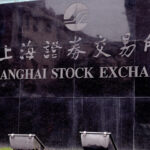Investors Cheer Liu He attending DC trade talks, MSCI/HKeX/Shenzhen Stock Exchange Meeting, CICC Chief Economist Dinner, FX Reserves, Luckin Coffee IPO
6 Min. Read Time
Hope all is well!
Key News Overnight
- Mid-day news that Vice Premier Liu He will be joining China’s trade delegation led to a late day rally. He had been scheduled for a Wednesday to Saturday trip which has been curtailed to just Thursday and Friday. Are investors calling Trump’s bluff after Lighthizer’s post market close announcement of Friday night tariffs? To some degree it appears so. The final round of negotiations is usually the hardest as both sides are jockeying for position. It seems feasible He’s trip is extended if talks go well on Friday though it is speculation on my part.
The Hang Seng had a roller coaster day as a morning rebound following Monday’s decline evaporated on rumors Liu He would not attend the DC meetings. The market did a well 180 on news he would attend to end the day +0.52%/+153 index points as volumes fell 29% day over day just above the one year average. There were 35 advancers and 13 decliners led by AIA +1.68%/+49.8 index points, Tencent +1.38%/+42 index points and HSBC +0.88%/+26.8 index points. The HK stocks within the MSCI China All Shares gained +0.42% as neither AIA nor HSBC are considered Chinese companies due to the HK and London domicile. Energy had a strong day +1.33% on an analyst upgrade and crude’s gain on Middle East tensions while financials -0.32% on an analyst downgrade. Tencent pulled communications +0.98% while healthcare had a good day +0.95%. Tech managed a small gain +0.1% despite trade tensions. Southbound Connect volumes were moderate in mixed trading as Bank of China saw 4 to 1 selling.
Shanghai & Shenzhen rebounded from yesterday’s fall +0.69% and +1.62% on volumes above the 1 year average but off -18% day over day as investors tiptoed back into stocks. Breadth was positive with 2,527 advancers and 1,054 decliners as small/mid caps outperformed mega/large caps as financials had a lackluster day. The mainland stocks within the MSCI China All Shares gained +0.95% led by real estate +1.91%, healthcare +1.54%, staples +1.47%, discretionary +1.45%, industrials +1.45% and communications +1.04%. Financials gained a mere +0.12% as the analyst downgraded weighed on the sector. Northbound Connect volumes were high as foreign investors pulled $168mm in mixed trading. Volume leader Kweichow Moutai saw 2 to 1 selling though Ping An Insurance had slightly more buyers than sellers.
We had the pleasure of having dinner with CICC Chief Economist and Head of Research Dr. Liang in NYC last night. Dr. Liang was Goldman Sachs’ China Chief Economist having worked at the IMF previously. We will publish the full meeting notes though below is a synopsis.
Economy – China has pivoted from a deleveraging campaign to monetary and fiscal stimulus driven by the trade war. While monetary easy has potentially slowed beginning in April, tax cuts have not trickled down into the economy which should be expected in the second half of 2019. Her base case is for China’s GDP to grow 6.4% in 2019 though several catalysts could increase GDP in 2020 and beyond (urbanization, SOE reform, pension contribution reform). Pension reform, tied to SOE reform, could unleash significant consumer buying.
Trade War – The trade war will accelerate China’s opening up providing opportunities in agriculture, financial services and leveling the playing field for private companies relative to SOEs. China has plenty of dry powder if a trade war drags on via monetary and fiscal stimulus. As the second largest economy in the world, a trade war that hurts China hurts the global economy, global multi-nationals and has a myriad of unintended consequences. Disruption of global supply chains especially in auto manufacturing could have significant repercussions. Ultimately no one likes to be told what to do (my kids can attest to this). Multi-nationals doing business in China could suffer from hard line trade tactics.
Stock Market – The rise of domestic consumption can be significantly increased through pension reform. China’s high savings rate is driven by mandatory pension contributions. If freed from this obligation domestic consumption could increase significantly. There are a multitude of beneficiaries including internet and e-commerce companies. Within the A Shares market industry leaders are poised to benefit from consumer upgrades which one would think means luxury goods. An industry leader could be an instant noodle companies, air conditioning maker or Moutai maker for instance. Pharma and high end manufacturing were favored sectors as well. Industry leaders will be beneficiaries of pension reforms which will include raising the equity ownership levels. For instance China’s social security fund is virtually 100% invested in Chinese Treasuries though this will change.
Risk/Misperceptions – Tightening/deleveraging could create economic risks to the downside though this is unlikely. China’s debt issue is by far the biggest misperception as investors fail to look at China’s assets and solely focus on debt. Japan is running very high debt/GDP though it is never mentioned due to recognition of the significant assets. China has very significant assets that mitigate the threat of poised by debt.
Dr. Liang spent significant time to SOE reform and pension reforms that require more time to fully articulate. MSCI’s China A inclusion and further opening up could see inflows into China for the foreseeable future. As always she was thoughtful and articulate in her thesis.
Institutional investor conference with MSCI, HK Stock Exchange and Shenzhen Stock Exchange:
MSCI – MSCI’s definition of Chinese A Shares will be added in three steps in 2019 raising their weight to over 3% of MSCI EM which is approximately the size of Mexico and Russia even with 80% more market cap to be added in 2020 and beyond. There are four impediments to full inclusion:
- Hedging – There have not been adequate vehicles for foreign investors to hedge long exposures though MSCI will launch a MSCI China A Index futures on the HK exchange very likely in Q3 or Q4 at the latest.
- Stock Connect Holidays – Stock Connect is closed on and the day before all HK and China holidays. This can resolved by eliminating some market holidays in China.
- Omnibus Accounts – Today A Shares owners need to trade each account individually without aggregating their accounts’ trades into one trade. This can be eliminated by adjusting the id system which would help meet best execution mandates.
- T+Zero settlement – Chinese A shares settle on the day of the trade versus most markets trade on trade day plus 2 days settlement. This is problematic as if I want to fund buying A Shares I have to trade two days prior or have a broker finance the trade. This is harder to solve as it would require moving all Chinese stocks settlement. Interestingly China is more advanced than other markets in this regard. I don’t believe T+0 prevents further inclusions in 2020 or beyond but is a factor in getting to full inclusion.
In the discussion, foreign ownership limits of 30% were brought up though Chinese regulators are aware of the issue and are apt to adjust the rule. An adjustment could significantly raise China’s weight further as we are only capturing a portion of the potential 90free float market cap.
The HK and Shenzhen Stock Exchanges spoke to the multiple index inclusions occurring in Chinese equities (MSCI, FTSE and S&P) and bonds (Bloomberg Global Aggregate) in 2019. Both noted the migration from QFII/RQFII quota schemes to Connect trading which now has 69 executing brokers and 17 custodians. China’s equity market is being institutionalized off of a low base as Shenzhen today is 80% retail trading and 43% of the stock ownership. Ultimately there is a lot more China coming benchmarks in 2019 and beyond.
MSCI announced the pro-forma for their May 28 rebalance will be released on May 13th at 11pm Central European summer time (5pm EST). Importance? We will know how the exact Chinese A Shares being added to the MSCI EM. While we have an indication based on MSCI’s end of February announcement the release provides a level of certainty.
China coffee chain Luckin Coffee will raise $586 million as the firm founded in October 2017 looks to fund its competition with Starbucks. The company will trade under ticker LK on the Nasdaq Exchange. The comparison to Starbucks is inaccurate as the company resembles Dunkin’ Donuts as it sells inexpensive coffee while Starbucks sells an experience.
Premier Li and the State Council announced cuts in red tape to assist businesses based on a mainland media report.
April Foreign Reserves: $3.094 trillion versus estimate $3.1 trillion and March’s $3.098 trillion.
Takeaway: FX reserves was a major media event. No more having stabilized. Dr. Liang mentioned that China’s FX reserve decline from the high of ~$4 trillion as an element went into US and global real estate. That has created issues as it bought high and priced out locals. I’ve not seen any analysis on China’s retracement has impacted global real estate prices. The release was after the market’s close.
Sequoia Capital is cutting 20% of staff as tech VC and PE investments shrank to $1.5B in Q1 from $9.4B in Q1 2018 according to a mainland media report.
CNY 6.76 versus 6.76 Monday
- Yield on 1 Day Chinese Gov’t Bond 1.37% versus 1.62% Monday
- Yield on 10 Year Chinese Gov’t Bond 3.38% Tuesday versus 3.38% Monday
- Yield on 10 Year China Development Bank Bond 3.77% Tuesday versus 3.77% Monday
Commodities were higher on the Shanghai & Dalian Exchanges with Dr. Copper +0.94%














